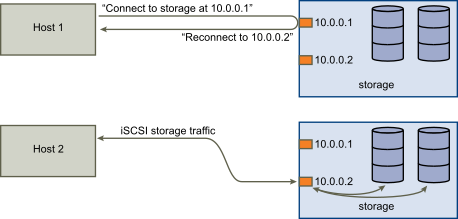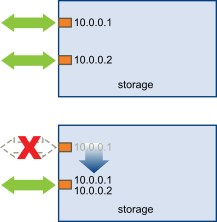Some iSCSI storage systems manage path use of their ports automatically and transparently to ESXi.
When using one of these storage systems, your host does not see multiple ports on the storage and cannot choose the storage port it connects to. These systems have a single virtual port address that your host uses to initially communicate. During this initial communication, the storage system can redirect the host to communicate with another port on the storage system. The iSCSI initiators in the host obey this reconnection request and connect with a different port on the system. The storage system uses this technique to spread the load across available ports.
If the ESXi host loses connection to one of these ports, it automatically attempts to reconnect with the virtual port of the storage system, and should be redirected to an active, usable port. This reconnection and redirection happens quickly and generally does not disrupt running virtual machines. These storage systems can also request that iSCSI initiators reconnect to the system, to change which storage port they are connected to. This allows the most effective use of the multiple ports.
The Port Redirection illustration shows an example of port redirection. The host attempts to connect to the 10.0.0.1 virtual port. The storage system redirects this request to 10.0.0.2. The host connects with 10.0.0.2 and uses this port for I/O communication.

If the port on the storage system that is acting as the virtual port becomes unavailable, the storage system reassigns the address of the virtual port to another port on the system. Port Reassignment shows an example of this type of port reassignment. In this case, the virtual port 10.0.0.1 becomes unavailable and the storage system reassigns the virtual port IP address to a different port. The second port responds to both addresses.

With this form of array-based failover, you can have multiple paths to the storage only if you use multiple ports on the ESXi host. These paths are active-active. For additional information, see iSCSI Session Management.